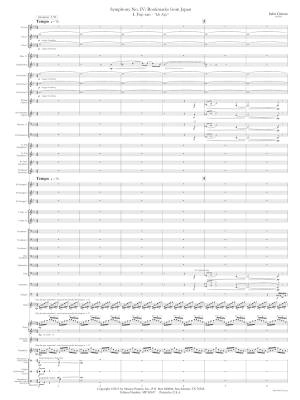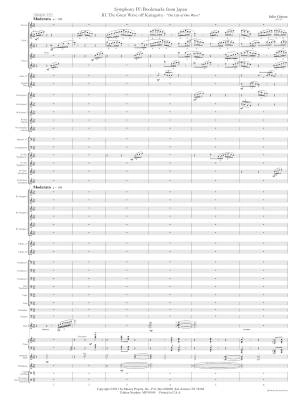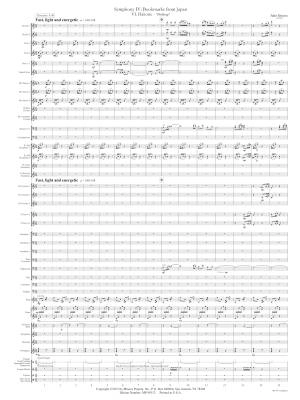Opens in a new window
Musica Propria Symphony No. IV: Bookmarks from Japan - Giroux - Concert Band - Gr. 4-6

Additional Photos:
Great Additions
Description
- Composer/Author: GIROUX, JULIE
- Instrumentation: CONCERT BAND
- Grade/Level: 4.5
- Model # MP99113
Composer: Julie Giroux
Format: Score and Parts
Instrumentation: Concert Band
Level: 4-6
Bookmarks From Japan is a Symphonic work in 6 movements based on a set of six Japanese bookmarks taken from historic Japanese wood-cut prints.
PROGRAM NOTES
I. Fuji-san - "Mt. Fuji"
Based on the bookmark "Fine Wind, Clear Morning" by Hokusai Katsushika which is a woodblock sketch from Hokusai's collection "Thirty-six Views of Mount Fuji."
The sketch "Fine Wind, Clear Morning" (Gaifu kaisei), also known as South Wind, Clear Sky or Red Fuji, by Hokusai Katsushika is the inspiration for this work which is subtitled "Fuji-san." In early autumn when, as the original sketch title specifies, the wind is southerly and the sky is clear, the rising sun can turn Mount Fuji red. Fuji-san has many different looks depending on the viewer's vantage point, time of year, weather and even time of day. Big, bold and easily recognized, yet shrouded in mystery and lore, Mount Fuji offers a multitude of inspirational facets. This piece is based on one view of Mt. Fuji covered in mist and low clouds which slowly burn off as the day progresses. Orchestration and composition techniques follow this scenario starting off with mysterious, unfocused scoring. As the piece progresses, the scoring gets more focused and bold with the final statement representing Fuji-san in a totally clear view.
Duration: 2:50
II. Nihonbashi - "Bridge Market"
Based on the bookmark "Nihonbashi" by Hiroshige Ando from the print series "The Fifty-three Stations of the Tokaido Highway."
Hiroshige Ando (1797-1858) travelled the Tokaido from Edo to Kyoto in 1832. The official party he was travelling with were transporting horses which were gifts to be offered to the imperial court. The journey greatly inspired Hiroshige for he sketched many of its scenes during his round trip travels. In all, Hiroshige produced 55 prints for the series "The Fifty-three Stations of the Tokaido Highway." Fifty-three of the prints represent each of the 53 post stations along the way. The two additional prints are of the starting and ending points. The post stations offered food, lodging and stables for travellers of the Tokaido Highway. This is Hiroshige's "Leaving Edo : Nihonbashi", "the bridge of Japan" and is number 1/55 in the series of prints.
The Nihonbashi bridge was the central point of development of what is now a business district of Chuo, Tokyo, Japan, aptly named the Nihonbashi District. For centuries it thrived as a mercantile district. The first department store ever developed in Japan was by the Mitsui family named Mitsukoshi. From its early days as a fish market to the current financial district of Tokyo (and Japan), this bridge spanning the Nihonbashi River is a true landmark in Tokyo. In fact, highway signs that state the distance to Tokyo actually state the distance to the Nihonbashi bridge.
Up until shortly before 1964, you could see Mount Fuji from the bridge. However, the 1964 Summer Olympics put in a raised expressway over the Nihonbashi bridge, obscuring the view of Mount Fuji entirely. Petitions to relocate the expressway underground in order to regain view of Mount Fuji are continuous but so far have been futile due to the costs for such a project.
Duration: 2:55
III. The Great Wave off Kanagawa - "The Life of One Wave"
Based on the bookmark "The Great Wave off Kanagawa" (lit. "Under a Wave off Kanagawa") by Hokusai Katsushika which is from Hokusai's collection "Thirty-six Views of Mount Fuji."
The artwork of Hokusai is well-known and this particular woodblock print, published between 1830 and 1833, is known throughout the world. His series "Thirty-six Views of Mount Fuji" is Hokusai's most famous work. Looking at this stunning print, you can see Mount Fuji in the background. However, the central focus is an enormous wave called an okinami (wave of the open sea), peaked and curling with several Japanese boats in different stages of entering the perilous wave.
In this work, a single wave is depicted from its beginnings far out in the sparkling, sun-drenched seas all the way through its final throes onto a rocky beach. The piece starts in the open sea, fairly calm with sunlight refracting into thousands of tiny points of light. Depicting this are the woodwinds rippling up and down with sixteenth triplet variations. The trombones and French horns enter the mix with a solid melodic statement. The trumpets are added near the end of the phrase, all of which depicts the first shaping of the great wave. This entire section peaks in measure 38 where we get the full rolling motion throughout the entire band. Just looking at the score, you can see the melodic lines and phrases going up and down the staves. From measures 40 to 45 the music winds down, ending with only two instruments playing. This signifies the separation of the wave from the open sea as it begins its final path towards landfall. Measure 45 to the end is its journey, growing in strength and volume to the final moments of this great wave.
Duration: 3:55
IV. Kinryu-zan Sensoji - "Thunder Gate"
The name of the print on the bookmark says "Kaminari-mon Gate of Asakusa Kannon Temple" but the true name of the print is "Kinryuzan Temple in Asakusa" by the artist Hiroshige Ando. Hiroshige died before before the entire collection was completed. Hiroshige II finished it. The first prints were published in order between 1856 and 1859.
Originally built in 941 AD, Kaminarimon is the outer gate leading to the Senso-ji Temple which was constructed around 628 AD near Kamagata and later relocated to its present location in Asakusa, Tokyo, Japan in 1635. This large gate features four statues. The Shinto gods Fujin and Raijin are located on the front of the gate and the Buddhist god Tenryu and goddess Kinryust and on the reverse side. Fujin, displayed on the front east side of the gate, is the god of wind and Raijin, on the west side, is the god of thunder, giving the gate its nickname of "Thunder Gate."
Displayed in the middle of the gate is a giant red chochin (lantern) which weighs approximately 1,500 pounds. Despite its huge size, it is very fragile. The front of the lantern bears the painting of the gate's name Kaminarimon, and the painting on the back reads Furaijinmon, the official name of the gate. The bottom or base of the chochin displays a beautiful wooden carving of a dragon. Over the centuries the gate has been destroyed and rebuilt many times. The current gate dates to 1960 and the new lantern was donated in 2003.
As a tourist, you cannot get close to the statues as they are protected by fences and wire and you certainly cannot touch them. Despite all of that, the magnificence of the gate still shines through, bearing testament to centuries of humans that have passed through its structure and those who will in the centuries yet to come.
Duration: 3:14
V. Evening Snow at Kambara
Based on the bookmark "Evening Snow at Kambara" by Hiroshige Ando from the print series "The Fifty-three Stations of the Tokaido Highway."
Hiroshige Ando (1797-1858) travelled the Tokaido from Edo to Kyoto in 1832. The official party he was travelling with was transporting horses which were gifts to be offered to the imperial court. The journey greatly inspired Hiroshige for he sketched many of its scenes during his journey's round trip. In all, Hiroshige produced 55 prints for the series "The Fifty-three Stations of the Tokaido Highway." Fifty-three of the prints represent the 53 post stations along the way. The additional two prints are of the starting and ending points. The post stations offered food, lodging and stables for travelers of the Tokaido Highway. "Evening Snow at Kambara" was the 15th station Hiroshige visited.
A song in structure, this piece sings of the soft and slow process of spiritual healing whose soft touch is not unlike that of falling snow. The piece starts with solo piano, harp and alto flute. The melody is simple, yet haunting, and grows with the slow addition of players. The piece ends with the same three soloists it began with. It is a song in structure, a song representing the soft touch of healing.
Duration: 3:50
VI. Hakone - "Drifting"
Based on the bookmark entitled "Hakone Pass" which is based on the actual print by Hiroshige Ando called "Hakone" from the print series "The Fifty-three Stations of the Tokaido Highway."
Hiroshige Ando (1797-1858) traveled the Tokaido from Edo to Kyoto in 1832. The official party he was traveling with was transporting horses which were gifts to be offered to the imperial court. The journey greatly inspired Hiroshige for he sketched many of its scenes during his journeys round trip. In all, Hiroshige produced 55 prints for the series "The Fifty-three Stations of the Tokaido Highway." Fifty-three of the prints represent the 53 post stations along the way. The additional two prints are of the starting and ending points. The post stations offered food, lodging and stables for travelers of the Tokaido Highway.
Hakone-juku was the tenth of the fifty-three stations of the Tokaido. At an elevation of 725m, it is the highest post station on the entire Tokaido offering spectacular views. Hakone-juku was established in 1618 and over the years has proven to be a hard road to maintain due to its elevation.
Duration: 4:00
Premiered by the Musashino Academy of Music Wind Ensemble Ray E. Cramer, Conducting in the Tokyo Metropolitan Theater Concert Hall Tokyo, Japan, July 16 2013
Format: Score and Parts
Instrumentation: Concert Band
Level: 4-6
Bookmarks From Japan is a Symphonic work in 6 movements based on a set of six Japanese bookmarks taken from historic Japanese wood-cut prints.
PROGRAM NOTES
I. Fuji-san - "Mt. Fuji"
Based on the bookmark "Fine Wind, Clear Morning" by Hokusai Katsushika which is a woodblock sketch from Hokusai's collection "Thirty-six Views of Mount Fuji."
The sketch "Fine Wind, Clear Morning" (Gaifu kaisei), also known as South Wind, Clear Sky or Red Fuji, by Hokusai Katsushika is the inspiration for this work which is subtitled "Fuji-san." In early autumn when, as the original sketch title specifies, the wind is southerly and the sky is clear, the rising sun can turn Mount Fuji red. Fuji-san has many different looks depending on the viewer's vantage point, time of year, weather and even time of day. Big, bold and easily recognized, yet shrouded in mystery and lore, Mount Fuji offers a multitude of inspirational facets. This piece is based on one view of Mt. Fuji covered in mist and low clouds which slowly burn off as the day progresses. Orchestration and composition techniques follow this scenario starting off with mysterious, unfocused scoring. As the piece progresses, the scoring gets more focused and bold with the final statement representing Fuji-san in a totally clear view.
Duration: 2:50
II. Nihonbashi - "Bridge Market"
Based on the bookmark "Nihonbashi" by Hiroshige Ando from the print series "The Fifty-three Stations of the Tokaido Highway."
Hiroshige Ando (1797-1858) travelled the Tokaido from Edo to Kyoto in 1832. The official party he was travelling with were transporting horses which were gifts to be offered to the imperial court. The journey greatly inspired Hiroshige for he sketched many of its scenes during his round trip travels. In all, Hiroshige produced 55 prints for the series "The Fifty-three Stations of the Tokaido Highway." Fifty-three of the prints represent each of the 53 post stations along the way. The two additional prints are of the starting and ending points. The post stations offered food, lodging and stables for travellers of the Tokaido Highway. This is Hiroshige's "Leaving Edo : Nihonbashi", "the bridge of Japan" and is number 1/55 in the series of prints.
The Nihonbashi bridge was the central point of development of what is now a business district of Chuo, Tokyo, Japan, aptly named the Nihonbashi District. For centuries it thrived as a mercantile district. The first department store ever developed in Japan was by the Mitsui family named Mitsukoshi. From its early days as a fish market to the current financial district of Tokyo (and Japan), this bridge spanning the Nihonbashi River is a true landmark in Tokyo. In fact, highway signs that state the distance to Tokyo actually state the distance to the Nihonbashi bridge.
Up until shortly before 1964, you could see Mount Fuji from the bridge. However, the 1964 Summer Olympics put in a raised expressway over the Nihonbashi bridge, obscuring the view of Mount Fuji entirely. Petitions to relocate the expressway underground in order to regain view of Mount Fuji are continuous but so far have been futile due to the costs for such a project.
Duration: 2:55
III. The Great Wave off Kanagawa - "The Life of One Wave"
Based on the bookmark "The Great Wave off Kanagawa" (lit. "Under a Wave off Kanagawa") by Hokusai Katsushika which is from Hokusai's collection "Thirty-six Views of Mount Fuji."
The artwork of Hokusai is well-known and this particular woodblock print, published between 1830 and 1833, is known throughout the world. His series "Thirty-six Views of Mount Fuji" is Hokusai's most famous work. Looking at this stunning print, you can see Mount Fuji in the background. However, the central focus is an enormous wave called an okinami (wave of the open sea), peaked and curling with several Japanese boats in different stages of entering the perilous wave.
In this work, a single wave is depicted from its beginnings far out in the sparkling, sun-drenched seas all the way through its final throes onto a rocky beach. The piece starts in the open sea, fairly calm with sunlight refracting into thousands of tiny points of light. Depicting this are the woodwinds rippling up and down with sixteenth triplet variations. The trombones and French horns enter the mix with a solid melodic statement. The trumpets are added near the end of the phrase, all of which depicts the first shaping of the great wave. This entire section peaks in measure 38 where we get the full rolling motion throughout the entire band. Just looking at the score, you can see the melodic lines and phrases going up and down the staves. From measures 40 to 45 the music winds down, ending with only two instruments playing. This signifies the separation of the wave from the open sea as it begins its final path towards landfall. Measure 45 to the end is its journey, growing in strength and volume to the final moments of this great wave.
Duration: 3:55
IV. Kinryu-zan Sensoji - "Thunder Gate"
The name of the print on the bookmark says "Kaminari-mon Gate of Asakusa Kannon Temple" but the true name of the print is "Kinryuzan Temple in Asakusa" by the artist Hiroshige Ando. Hiroshige died before before the entire collection was completed. Hiroshige II finished it. The first prints were published in order between 1856 and 1859.
Originally built in 941 AD, Kaminarimon is the outer gate leading to the Senso-ji Temple which was constructed around 628 AD near Kamagata and later relocated to its present location in Asakusa, Tokyo, Japan in 1635. This large gate features four statues. The Shinto gods Fujin and Raijin are located on the front of the gate and the Buddhist god Tenryu and goddess Kinryust and on the reverse side. Fujin, displayed on the front east side of the gate, is the god of wind and Raijin, on the west side, is the god of thunder, giving the gate its nickname of "Thunder Gate."
Displayed in the middle of the gate is a giant red chochin (lantern) which weighs approximately 1,500 pounds. Despite its huge size, it is very fragile. The front of the lantern bears the painting of the gate's name Kaminarimon, and the painting on the back reads Furaijinmon, the official name of the gate. The bottom or base of the chochin displays a beautiful wooden carving of a dragon. Over the centuries the gate has been destroyed and rebuilt many times. The current gate dates to 1960 and the new lantern was donated in 2003.
As a tourist, you cannot get close to the statues as they are protected by fences and wire and you certainly cannot touch them. Despite all of that, the magnificence of the gate still shines through, bearing testament to centuries of humans that have passed through its structure and those who will in the centuries yet to come.
Duration: 3:14
V. Evening Snow at Kambara
Based on the bookmark "Evening Snow at Kambara" by Hiroshige Ando from the print series "The Fifty-three Stations of the Tokaido Highway."
Hiroshige Ando (1797-1858) travelled the Tokaido from Edo to Kyoto in 1832. The official party he was travelling with was transporting horses which were gifts to be offered to the imperial court. The journey greatly inspired Hiroshige for he sketched many of its scenes during his journey's round trip. In all, Hiroshige produced 55 prints for the series "The Fifty-three Stations of the Tokaido Highway." Fifty-three of the prints represent the 53 post stations along the way. The additional two prints are of the starting and ending points. The post stations offered food, lodging and stables for travelers of the Tokaido Highway. "Evening Snow at Kambara" was the 15th station Hiroshige visited.
A song in structure, this piece sings of the soft and slow process of spiritual healing whose soft touch is not unlike that of falling snow. The piece starts with solo piano, harp and alto flute. The melody is simple, yet haunting, and grows with the slow addition of players. The piece ends with the same three soloists it began with. It is a song in structure, a song representing the soft touch of healing.
Duration: 3:50
VI. Hakone - "Drifting"
Based on the bookmark entitled "Hakone Pass" which is based on the actual print by Hiroshige Ando called "Hakone" from the print series "The Fifty-three Stations of the Tokaido Highway."
Hiroshige Ando (1797-1858) traveled the Tokaido from Edo to Kyoto in 1832. The official party he was traveling with was transporting horses which were gifts to be offered to the imperial court. The journey greatly inspired Hiroshige for he sketched many of its scenes during his journeys round trip. In all, Hiroshige produced 55 prints for the series "The Fifty-three Stations of the Tokaido Highway." Fifty-three of the prints represent the 53 post stations along the way. The additional two prints are of the starting and ending points. The post stations offered food, lodging and stables for travelers of the Tokaido Highway.
Hakone-juku was the tenth of the fifty-three stations of the Tokaido. At an elevation of 725m, it is the highest post station on the entire Tokaido offering spectacular views. Hakone-juku was established in 1618 and over the years has proven to be a hard road to maintain due to its elevation.
Duration: 4:00
Premiered by the Musashino Academy of Music Wind Ensemble Ray E. Cramer, Conducting in the Tokyo Metropolitan Theater Concert Hall Tokyo, Japan, July 16 2013
Media
Movement 1
Press play to listen
Movement 2
Press play to listen
Movement 3
Press play to listen
Movement 4
Press play to listen
Movement 5
Press play to listen
Movement 6
Press play to listen
Q & A
There are currently no questions for this product.
Reviews
There are currently no reviews for this product. Be the first to write one!







